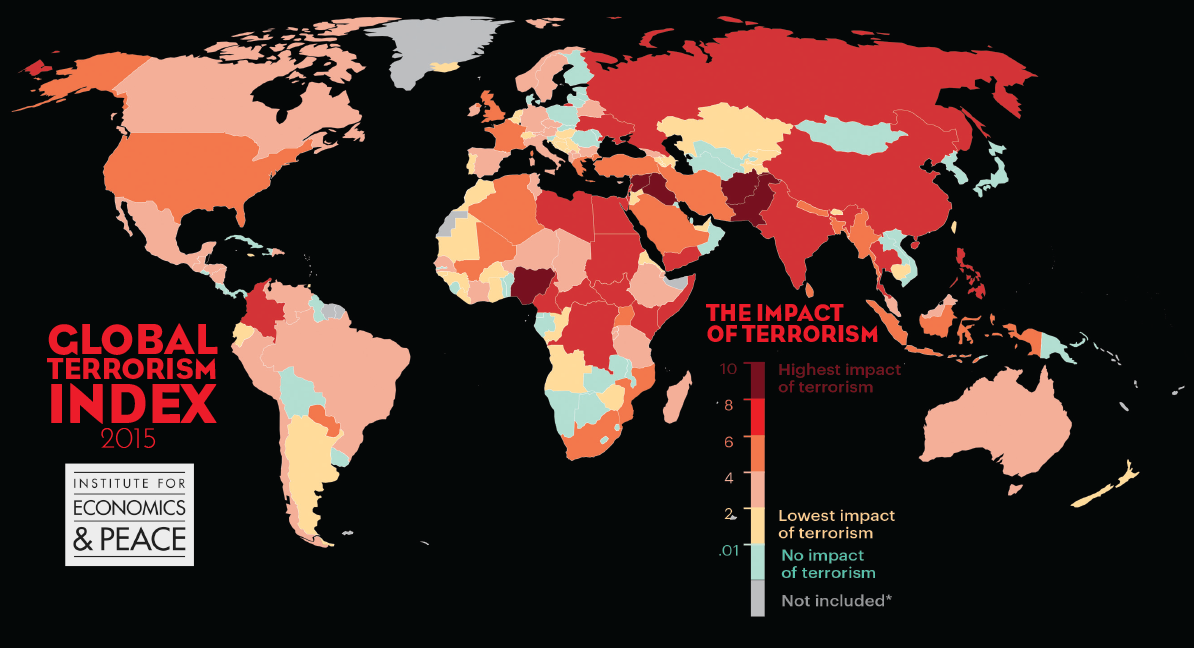New Atheism, Meet Existential Risk Studies

While the New Atheist movement isn’t, and has never been, a monolithic phenomenon, its primary motivating idea can be reduced to a single statement, namely that religion is not merely wrong, but dangerous. In fact, religion is dangerous precisely because it’s wrong: it commands believers to act according to “moral” precepts and guidelines that are ultimately based on private revelations had by ancient prophets claiming special access to the supernatural. Put differently, religion is our very best instance of institutionalized bad epistemology, and this is what makes it unreasonable to accept. And when its doctrinal systems are put into practice, they often compromise our well-being and prosperity.
Copious evidence substantiates this contention. On the one hand, history is overflowing with bloody conflicts driven by antagonistic religious dogmas held by fanatics who cared more about the otherworldly than the worldly. And, as the 2014 Global Terrorism Index affirms, religious extremism constitutes the primary driver of terrorism around the world today. Even more, numerous empirical studies have shown that, to quote the sociologist Phil Zuckerman, secular people are “markedly less nationalistic, less prejudiced, less anti-Semitic, less racist, less dogmatic, less ethnocentric, less close-minded, and less authoritarian” than religious people. And the most secularized countries tend to be the happiest, the most peaceable (according to the Global Peace Index), and, as reported by the Economist’s think tank several years ago, the “best places to be born.” While Christopher Hitchens’ declaration that “religion poisons everything” might be somewhat exaggerated, religious belief is consistently associated with diminished levels of human flourishing.
But I believe that the New Atheist’s position is even more compelling than the New Atheists themselves have previously realized. Concomitant with the rise of the New Atheist movement about a decade ago, another field took shape in some of the top universities around the world, most notably Oxford and Cambridge. This field, called existential risk studies (or existential riskology), grew out of the innovative work of thinkers like John Leslie, Sir Martin Rees, Richard Posner, and Nick Bostrom. Its focus is a special kind of tragedy known as an existential risk, or a catastrophe resulting in either our extinction or a state of permanent and severe deprivation.
While humanity has always been haunted by a small number of improbable threats to our survival, such as asteroid/comet impacts, supervolcanoes, and pandemics (call these our “cosmic risk background”), advanced technologies are introducing a constellation of brand-new existential risks that humanity has never before encountered—and therefore has no track record of surviving. These risks stem largely from technologies like nuclear weapons, biotechnology, synthetic biology, nanotechnology, and even artificial superintelligence, which a growing number of scholars identify as the greatest (known) threat to the long-term survival of humanity. Add to this the ongoing slow-motion catastrophes of climate change and biodiversity loss that threaten our planetary spaceship with environmental ruination. While these two risks could genuinely bring about our extinction, they’re probably best described as “conflict multipliers” that will nontrivially raise the probability of other risk scenarios being realized, as state and non-state actors compete for land and dwindling resources.
Taking all of this into account, many riskologists believe that the probability of an existential catastrophe occurring in the foreseeable future is unsettlingly high. For example, last year the Bulletin of Atomic Scientists moved the minute hand of its Doomsday Clock (a metaphorical clock according to which midnight represents doom) from five minutes before midnight to a mere three minutes. And in January, Bulletin board members (including 2015 Humanist of the Year Lawrence Krauss) held a press conference to announce that despite the Paris climate agreement and the Iran nuclear deal, the hands of the clock would not move from their perilous position in 2016. As a point of reference, the furthest away from midnight that we’ve been since the Doomsday Clock was created in 1947 is seventeen minutes, at the close of the Cold War. And only once before, at the height of the Cold War, has the hand been closer than it currently is today.
Consistent with this, the influential Stern Review, a 2006 report led by the economist Nicholas Stern, puts the probability of human extinction before 2100 at around 10 percent. And the founder of the Future of Humanity Institute at Oxford, Nick Bostrom, writes that “setting this probability lower than 25 percent would be misguided, and the best estimate may be considerably higher.” Similarly, the Astronomer Royal and cofounder of Cambridge’s Centre for the Study of Existential Risks declares in his 2003 book Our Final Hour that humanity has a mere fifty-fifty chance of survival this century. While these estimates may sound alarmist to the untrained ear, it’s important to recognize that there’s a huge difference between being an alarmist and being alarmed. To adapt a phrase from the philosopher David Hume, wise people always proportion their fears to the best available evidence, considered as a whole. When this maxim is followed, one finds that there really is good reason for heightened existential anxiety this century.
But destructive tools can’t induce a disaster without an agent wielding them. This leads to an important distinction between error and terror, based on the role of intention in each. As I explore in my forthcoming book, The End: What Science and Religion Tell Us About the Apocalypse, there are a shocking number of accidents, mistakes, slip-ups, oversights, and miscalculations that have very nearly resulted in a nuclear holocaust, global pandemic, or other such catastrophe. The real and ongoing threat of error can hardly be overemphasized. Yet it’s not the primary source of existential apprehension among the experts. This designation goes to the category of terror—and it’s here that religion enters the picture in a huge way.

Photo by Miro9966
As mentioned, religion is now the primary driver of global terrorism. And studies show that religious terrorism is far more lethal and indiscriminate in its targets than past forms of “secular” terrorism motivated by anarchist, nationalist, and Marxist ideologies. Even more, it’s become increasingly apocalyptic over the past several decades, most notably in the Islamic world. This is worrisome because apocalyptic convictions, when genuinely held, can produce in the true believer a grandiose sense of moral urgency that one can use to justify virtually any act of cruelty or violence, no matter how catastrophic. To be sure, most believers around the world see religious eschatology as something like a “spectator sport.” But history reveals a small percentage of particularly fervent people at the fringe who prefer an “active cataclysmic” approach to end-times issues (to borrow a term from Richard Landes of the Center for Millennial Studies). Such individuals see themselves as active participants in an apocalyptic narrative that’s unfolding in real time—a narrative that they’re helping to catalyze. These so-called eschatological activists are arguably the most dangerous type of believer, since they hold with the unshakable firmness of faith that the world must be destroyed in order to be saved. God commands the apocalyptic warrior to pursue mass homicide, genocide, and even humanicide, and the only acceptable outcome is absolute victory over the enemies of their “truth.”
While the ancient roads of history are littered with “active cataclysmic” groups that rose and fell without bringing about an existential nightmare for humanity, the situation today is different. We’re entering a genuinely new era in which the end-times fantasies of religious extremists could actually be realized through the malicious exploitation of advanced technologies. The fact is that many of these technologies are not only becoming more powerful (at something like an exponential rate), but some are also becoming more accessible to small groups and even lone wolves. These dual trends will thus enable more and more individuals to manipulate and rearrange the physical world in increasingly profound ways. At the extreme, it’s not implausible to imagine a future world crowded with levers that, when pulled, could obliterate civilization. Advanced technologies are raising the stakes immensely, and apocalyptic groups with a death wish for humanity could use them to initiate catastrophes unlike anything humanity has ever before witnessed.
But the danger posed by religiously motivated terror is even more ominous than this. There are actually reasons for thinking not only that fanatical religious groups will be empowered to wreak unprecedented havoc on society, but that such groups will actually increase in size and frequency. First, consider the 2015 Pew poll finding that religious belief is growing worldwide. This suggests that the number of extremists on the fringe of mainstream tradition is growing as well. Indeed, if statistics about end-times beliefs remain steady moving forward (e.g., 41 percent of Americans in 2010 believed that Jesus will either “definitely” or “probably” return by 2050), there will quite literally be billions of people by the middle of this century who expect Armageddon to be just around the corner, and tens of millions who adhere to active apocalyptic ideologies.
Furthermore, and even more interestingly, history reveals a pattern of apocalyptic movements arising during periods of significant social reorganization, economic uncertainty, and political instability. As the scholar Mark Juergensmeyer (Terror in the Mind of God) puts it, “radical change breeds radical religion.” This can, in fact, be observed looking back over the past decade with the rise of the Islamic State—an apocalyptic death cult par excellence—in the chaotic aftermath of the Iraq War. After years of violence, bloodshed, and death, members of the less apocalyptic al-Qaeda split off to form an Islamic “state” that explicitly aims to catalyze events leading up to the so-called Last Hour. According to their belief system, they anticipate an imminent grand battle—essentially Armageddon—to occur in the small Syrian town of Dabiq. The victorious Muslim forces will then proceed to conquer Constantinople, after which Jesus will descend over Damascus and kill the Antichrist in Israel. This is why the Islamic State has repeatedly taunted the West to meet them on the ground in Syria. As an Islamic State militant put it in a 2014 propaganda video, with the severed head of a U.S. aid worker lying at his feet, “Here we are, burying the first American crusader in Dabiq, eagerly waiting for the remainder of your armies to arrive.”

The post-2003 Middle East also witnessed the rise of several apocalyptic Shia militia in Iraq, such as the Mahdi Army (named after Islam’s end-of-days messianic figure) and later the Promised Day Brigade, which is known to receive funding and training from the Islamic Republic of Iran, a state whose creation in 1979 was widely seen as an “apocalyptic occurrence.” And the Lebanese terrorist group Hezbollah was once a rather secular-Marxist organization, but in the past decade has begun to incorporate eschatological themes into its propaganda.
The point of these examples is to emphasize that societal conditions of instability and deterioration are the fertilizer of apocalyptic activism. They’re also precisely the sort of conditions that we can expect more of in the future. Why? Because of climate change and biodiversity loss (as well as other phenomena, which I won’t discuss here). These are conflict multipliers that will almost certainly result in major disruptions to society, threatening the very identity and perpetuation of certain socio-cultural groups. And as Juergensmeyer points out in a detailed study of the subject, loss of identity and existential fear are often triggers for the rise of apocalyptic movements. When the world looks like it’s about to end, some religiously-inclined believers will become convinced that it really is.
As a matter of fact, a 2015 article published in the Proceedings of the National Academy of Sciences suggests that one can draw a fairly straight line of causation from anthropogenic climate change through the record-breaking 2007-2010 Syrian drought, the outbreak of the Syrian civil war, and the rise of the Islamic State circa 2014. So we already have one instance of climate change contributing to the rise of apocalyptic madness. Just imagine what might happen if the dire predictions of climatologists were to come true later this century, or if the biosphere were to cross a “critical threshold” that plunged the global ecosystem into a state of irreversible, catastrophic collapse, as a 2012 paper published in Nature affirms could happen.
While the world is getting better in plenty of respects—as both Steven Pinker (The Better Angels of Our Nature) and Michael Shermer (The Moral Arc) convincingly argue—the world is also becoming far more perilous. The truth is that religion has always been dangerous, because it’s always been believable to enough people. But when one combines this with the central insights of existential risk studies, it becomes clear that religious belief could present unprecedented challenges in the coming decades. Speculatively speaking, perhaps every intelligent species in the universe encounters a transitional period of awkward adolescence in which the “instrumental rationality” of its means exceeds the “moral rationality” of its ends—and perhaps this means-ends mismatch constitutes a Great Filter (a la Fermi) beyond which the existence of beings like us becomes highly improbable. This collision could offer a solution to the Fermi paradox, which asks, “If the universe is teeming with life, as it should be, then where is everybody?”
New Atheism and its emphasis on the good epistemology of evidence-based reasoning will thus only become more relevant—and urgently important—in the future. Mitigating the influence of religion is, I believe, one of the most important tasks that secularists could pursue in the twenty-first century. This is more than about being on the right side of history, it’s about being on what I like to call the “right side of futurology.” The fact is that we’re no longer children playing with matches, like we’ve been for most of our history—often with devastating results. Rather, we’re children playing with flamethrowers that could easily burn down the whole global village. In the absence of a parental figure to watch over us, our only option is to grow up as a species, as the late Christopher Hitchens liked to say. And this means divesting ourselves of the radical faith-based fantasies that are actively inching us closer to the precipice of disaster.
